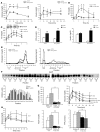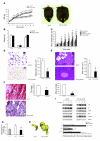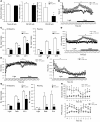Obesity-associated improvements in metabolic profile through expansion of adipose tissue
- PMID: 17717599
- PMCID: PMC1950456
- DOI: 10.1172/JCI31021
Obesity-associated improvements in metabolic profile through expansion of adipose tissue
Abstract
Excess caloric intake can lead to insulin resistance. The underlying reasons are complex but likely related to ectopic lipid deposition in nonadipose tissue. We hypothesized that the inability to appropriately expand subcutaneous adipose tissue may be an underlying reason for insulin resistance and beta cell failure. Mice lacking leptin while overexpressing adiponectin showed normalized glucose and insulin levels and dramatically improved glucose as well as positively affected serum triglyceride levels. Therefore, modestly increasing the levels of circulating full-length adiponectin completely rescued the diabetic phenotype in ob/ob mice. They displayed increased expression of PPARgamma target genes and a reduction in macrophage infiltration in adipose tissue and systemic inflammation. As a result, the transgenic mice were morbidly obese, with significantly higher levels of adipose tissue than their ob/ob littermates, leading to an interesting dichotomy of increased fat mass associated with improvement in insulin sensitivity. Based on these data, we propose that adiponectin acts as a peripheral "starvation" signal promoting the storage of triglycerides preferentially in adipose tissue. As a consequence, reduced triglyceride levels in the liver and muscle convey improved systemic insulin sensitivity. These mice therefore represent what we believe is a novel model of morbid obesity associated with an improved metabolic profile.
Figures







References
-
- Scherer P.E. Adipose tissue: from lipid storage compartment to endocrine organ. Diabetes. 2006;55:1537–1545. - PubMed
-
- Pajvani U.B., et al. Fat apoptosis through targeted activation of caspase 8: a new mouse model of inducible and reversible lipoatrophy. Nat. Med. 2005;11:797–803. - PubMed
-
- Yki-Jarvinen H. Fat in the liver and insulin resistance. Ann. Med. 2005;37:347–356. - PubMed
Publication types
MeSH terms
Substances
Grants and funding
- DK026687/DK/NIDDK NIH HHS/United States
- R01-DK55758/DK/NIDDK NIH HHS/United States
- R01-DK066618/DK/NIDDK NIH HHS/United States
- U24 DK059635/DK/NIDDK NIH HHS/United States
- DK59630/DK/NIDDK NIH HHS/United States
- R01 DK040936/DK/NIDDK NIH HHS/United States
- R01-CA112023/CA/NCI NIH HHS/United States
- R24 DK071030/DK/NIDDK NIH HHS/United States
- R24-DK071030-01/DK/NIDDK NIH HHS/United States
- P30 DK026687/DK/NIDDK NIH HHS/United States
- U24 DK059630/DK/NIDDK NIH HHS/United States
- R01 DK066618/DK/NIDDK NIH HHS/United States
- R21-DK075887/DK/NIDDK NIH HHS/United States
- R21 DK075887/DK/NIDDK NIH HHS/United States
- R01 DK055758/DK/NIDDK NIH HHS/United States
- R01 CA112023/CA/NCI NIH HHS/United States
LinkOut - more resources
Full Text Sources
Other Literature Sources
Medical
Molecular Biology Databases
Research Materials
Miscellaneous

